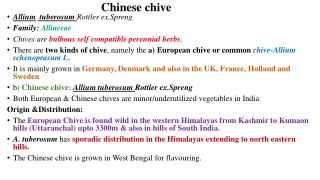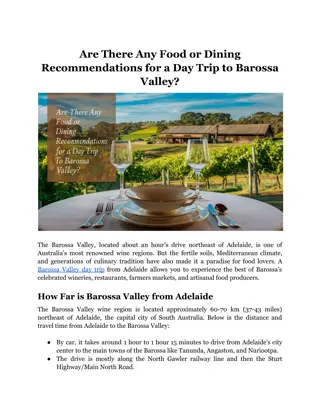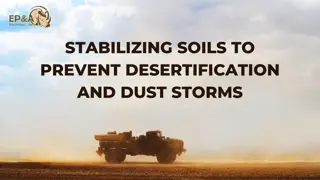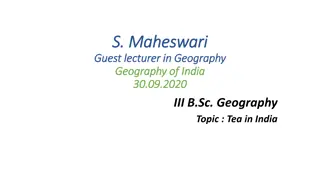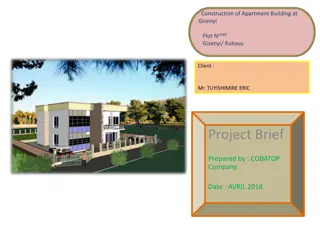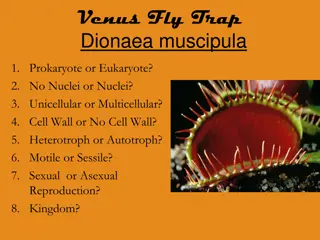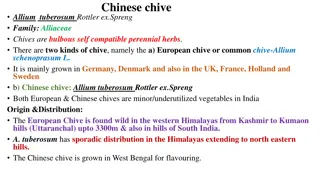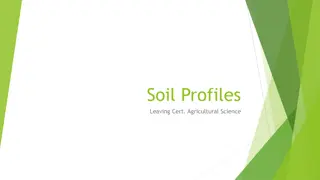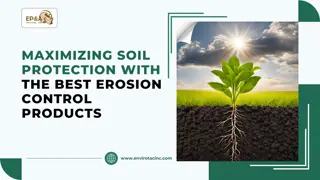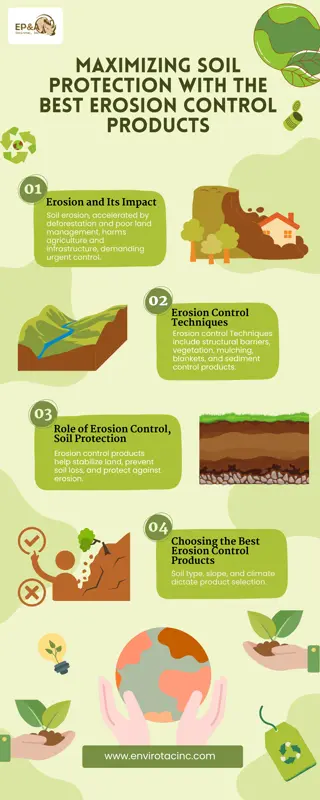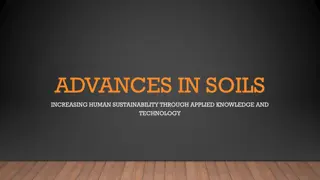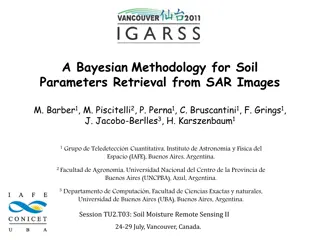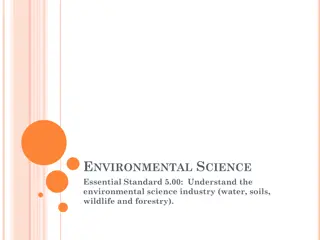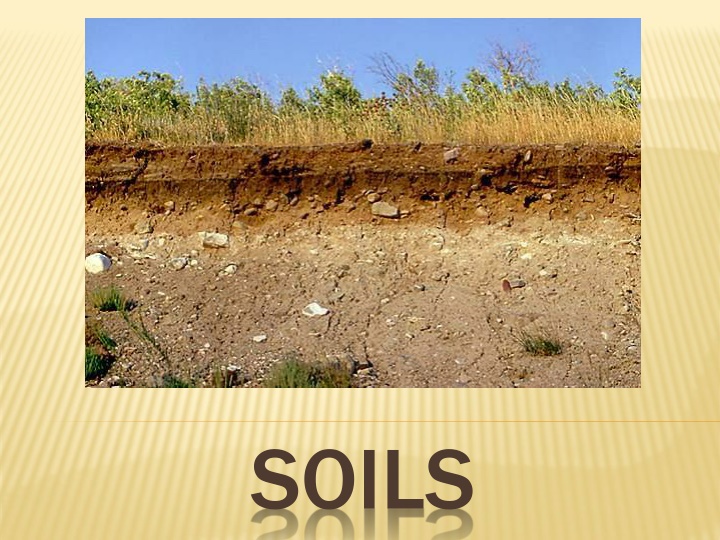
Unveiling the Intriguing World of Soil
Soil, a complex mixture formed by weathering and organic material, plays a crucial role in supporting vegetation, plant growth, nutrient cycling, and gas exchange. Factors like parent material, climate, organisms, topography, and time influence soil formation. Components of soil include organic matter, water, air, and nutrients. Understanding the functions and components of soil, such as organic matter breakdown, water movement, and plant nutrients, sheds light on the vital ecosystem services it provides.
Download Presentation

Please find below an Image/Link to download the presentation.
The content on the website is provided AS IS for your information and personal use only. It may not be sold, licensed, or shared on other websites without obtaining consent from the author. If you encounter any issues during the download, it is possible that the publisher has removed the file from their server.
You are allowed to download the files provided on this website for personal or commercial use, subject to the condition that they are used lawfully. All files are the property of their respective owners.
The content on the website is provided AS IS for your information and personal use only. It may not be sold, licensed, or shared on other websites without obtaining consent from the author.
E N D
Presentation Transcript
WHAT IS SOIL Formed by weathering, erosion, and the combining of those rock particles with air, water, and organic material It can take 100 to 600 years or more for nature to make one inch of topsoil
SOIL FORMATION FACTORS Parent Material Climate Organisms Topography Time
FUNCTIONS OF SOIL Provides support and anchorage for vegetation Medium for plant growth and crop production Primary cleansing and recycling medium Sustains biological activity, diversity and production Stores and cycles nutrients and other elements Allows gas exchange
COMPONENTS OF SOIL Organic matter Water Air Nutrients/minerals
ORGANIC MATTER Consists of the remains of plants and animals With favorable temperature and moisture, animals and fungi break down organic matter to humus and soluble nutrients accessible to growing plants Types of plants growing in the soil, management practices, temperature, and drainage determine the amount of organic matter
WATER From precipitation entering soil cracks, holes, and openings between soil particles Used by plants Lost to evaporation and run-off Moves deep within the ground, inaccessible to plants
AIR Air in the soil contains less oxygen and more carbon dioxide than air above the soil surface Air is pushed out of the soil as water enters Plant roots take up oxygen for respiration Roots die if air is unavailable for long periods of time
PLANT NUTRIENTS/ MINERALS 18 elements essential for plant growth Nitrogen - most important, nitrogen-fixing bacteria Carbon, Hydrogen and Oxygen - from air and water Iron, calcium, phosphorus, potassium, copper, sulfur, magnesium, manganese, zinc, boron, chlorine, cobalt, nickel, and molybdenum - from soil
PROPERTIES Permeability Water holding capacity Porosity
PERMEABILITY The rate at which water moves through soil Affected by the amount, size, and arrangement of pores. Macropores, such as sand, can increase permeability
WATER HOLDING CAPACITY The ability of a soil s micropores to hold water for plant use Affected by the amount, size and arrangement of pores
POROSITY Soil texture Soil structure Compaction Organic matter
SOIL TEXTURE The relative proportions of sand, silt and clay
PARTICLE TYPES Sand - particles of 2 to .05 mm diameter Silt - particles .05 to .0002 mm diameter Clay - <.0002 mm diameter Loam - contains soils whose properties consist almost equally of clay, silt, and sand separates
STRUCTURE The nature of the arrangement of primary particles into naturally formed secondary particles called aggregates Profound influence on porosity and balance between large and small pores Types Granular Blocky Platy Columnar/Prismatic
GRANULAR Individual particles of sand, silt, and clay grouped together in small, nearly spherical grains Water easily circulates Common in surface soils with high organic matter content
BLOCKY Soil particles that cling together in nearly square or angular blocks having more or less sharp edges Resists penetration and movement of water Common in subsoils, especially in humid regions
PLATY Made up of soil particles aggregated in thin plates or sheets piled horizontally on one another Plates often overlap, greatly impairing water circulation Common with puddling or ponding of soils
COLUMNAR Soil particles that have formed into vertical columns or pillars separated by miniature, but definite vertical cracks Water circulation and drainage is poor Common in subsoils in arid and semi-arid regions
COMPACTION Destroys soil quality Reduces pore size Less space for air and water Difficult for plants to grow roots
REDUCING COMPACTION Add organic matter Reduce trips across the area Practice reduced-till or no till systems Harvest when soils are not wet
SOIL PROFILE 6 layers O:Organic A: Topsoil E: Eluviated B:Subsoil C: Parent Material R: Bedrock
O HORIZON Organic Top layer of soil Made of fresh to partially decomposed organic matter Color varies from brown to black
A HORIZON Top Soil 2ndlayer Top portion made of highly decomposed organic matter Color ranges from brown to gray
E HORIZON Eluviated 3rdlayer Made of mostly sand and silt Has lost most of its minerals
B HORIZON Sub soil 4thlayer More clay and bigger bedrock Reddish brown or tan in color
C HORIZON Parent Material 5thlayer Weathered bedrock Cracked and broken surface of the bedrock
R HORIZON Bedrock Last layer Made of unweathered rocks

